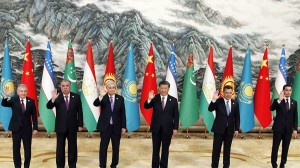 Chinese President Xi Jinping has announced a new policy for the development of Central Asia, comprising initiatives such as infrastructure construction for better trade activities and adopting integration-based development projects.
Chinese President Xi Jinping has announced a new policy for the development of Central Asia, comprising initiatives such as infrastructure construction for better trade activities and adopting integration-based development projects.
President Xi Jinping has declared China’s preparation to fulfill development strategies with Kazakhstan, Kyrgyzstan, Tajikistan, Turkmenistan and Uzbekistan, while actively promoting modernization across the region during the China-Central Asia Summit in May 2023. The leaders of the six regional countries met in person for the first time for the summit and signed the Xi’an Declaration.
The five Central Asian nations were part of the Soviet Union. The region has been an area of imperial domination of various civilizations for centuries. Today, post-Soviet republics present a network of trade corridors that offer alternative routes for transporting commodities such as energy sources, food, and other goods.
During the meeting, Central Asian countries and China approved regional grants totaling around $4 billion. They also signed 54 significant multilateral agreements, established 19 new regional platforms, and signed an additional nine documents of multilateral cooperation. Each of these measures aims to promote regional development and enhance collaboration between participating nations.
Kazakh President Kassym Jomart Tokayev expressed his positivity about China-Central Asian economic relations and underscored the potential to increase trade with China to $100 billion by 2030. This would mean a 30% increase from the current trade level of $70 billion. To achieve this, an estimated annual trade growth of $4.3 billion would be required until that period. We should note that the trade turnover between Central Asia and China was only $1.5 billion in 2001.
At the summit, Kazakhstan and China signed a deal for a new industrial exchange program, indicating their dedication to strengthening economic ties. China also pledged its support to Kazakh businesses operating in China and expressed its intention to boost tourism to Kazakhstan.
For Kyrgyzstan, a new investment fund was announced. The Kyrgyz side made an invitation for Chinese banks and businesses to open branches in the country. Currently, up to 2000 Chinese companies operate in the country. Similar decisions were taken between China and Uzbekistan, Kazakhstan and Tajikistan. Each statement contains specific agreements and commitments.
Notably, China plans to establish a new secretariat, featuring 19 separate channels of direct engagement with Central Asia. This represents a shift from China’s traditional presence in the region with its standard bilateral relations. Beijing aims to integrate the Central Asian countries with its economic prospects, irrespective of any domestic political issues.
Furthermore, the participants of the summit reaffirmed their commitment to various infrastructure projects, including the China-Kyrgyzstan-Uzbekistan railway, which is worth $4.5 billion, highways connecting China to Kyrgyzstan, Tajikistan, and Uzbekistan, and the development of transport infrastructure for trans-Caspian trade routes.
Central Asian countries are welcoming project proposals and the economic efforts of China, as Beijing intensifies its campaign in the region. The war in Ukraine has decreased Russia’s attention while the U.S.’ withdrawal from Afghanistan has lowered America’s focus on the region. Actually, the U.S.’ influence has always remained lower than those of other regional players since the beginning of the 1990s with the exception of the post-9/11 period.
China’s new challenge also weakens the Russian-led Eurasian Economic Union’s functions. The Belt and Road Initiative, which was announced in Kazakhstan in 2013, has already created the first step of a regional economic integration framework. Russia has remained the big boss of the region for centuries but now China’s new attempts also change the security balances. Beijing’s special focus on Tajikistan is just the beginning.
China is actively establishing defense cooperation with these regional countries. Here, Tajikistan presents strategic importance since it is a buffer zone between China and Afghanistan. Especially, the Chinese interest in the Wakhan Corridor requires a strong security partnership with Tajikistan. Both countries signed an agreement for joint military exercises to be launched every two years.
Beijing has also built frontier posts and a security training center near the Tajikistan-Afghanistan border. The Chinese military’s existence in Tajikistan can spread to other regional countries after a series of attractive economic projects in the future, on one condition: raising arms sales. Currently, Russia’s leading role in arms sales cannot be beaten by China. However, the future efforts of China can change this situation as well.
Dr. Mehmet Fatih Oztarsu- The Korea Times: link

 Haziran 14th, 2023
Haziran 14th, 2023  oztarsu
oztarsu  Posted in
Posted in  Tags:
Tags: